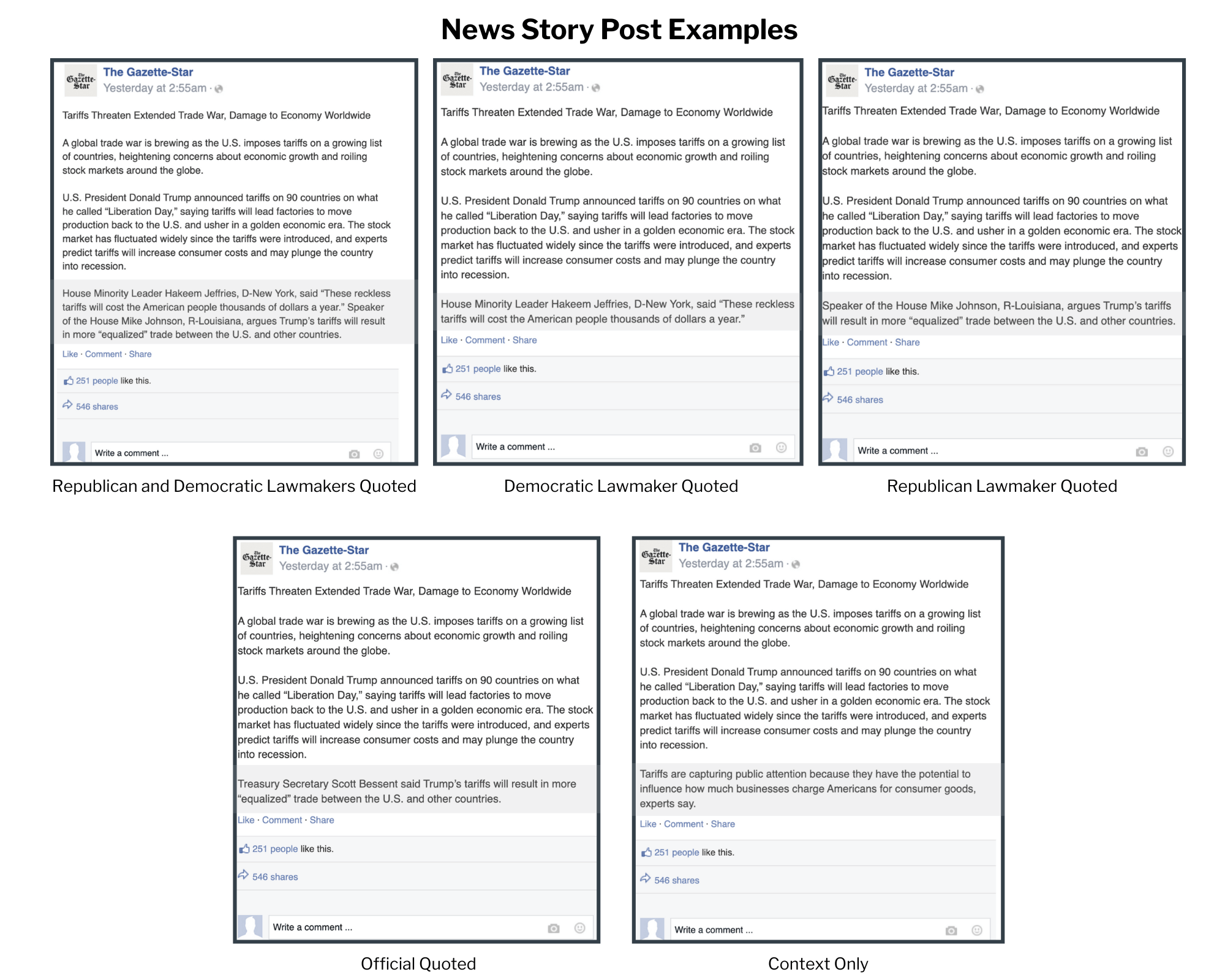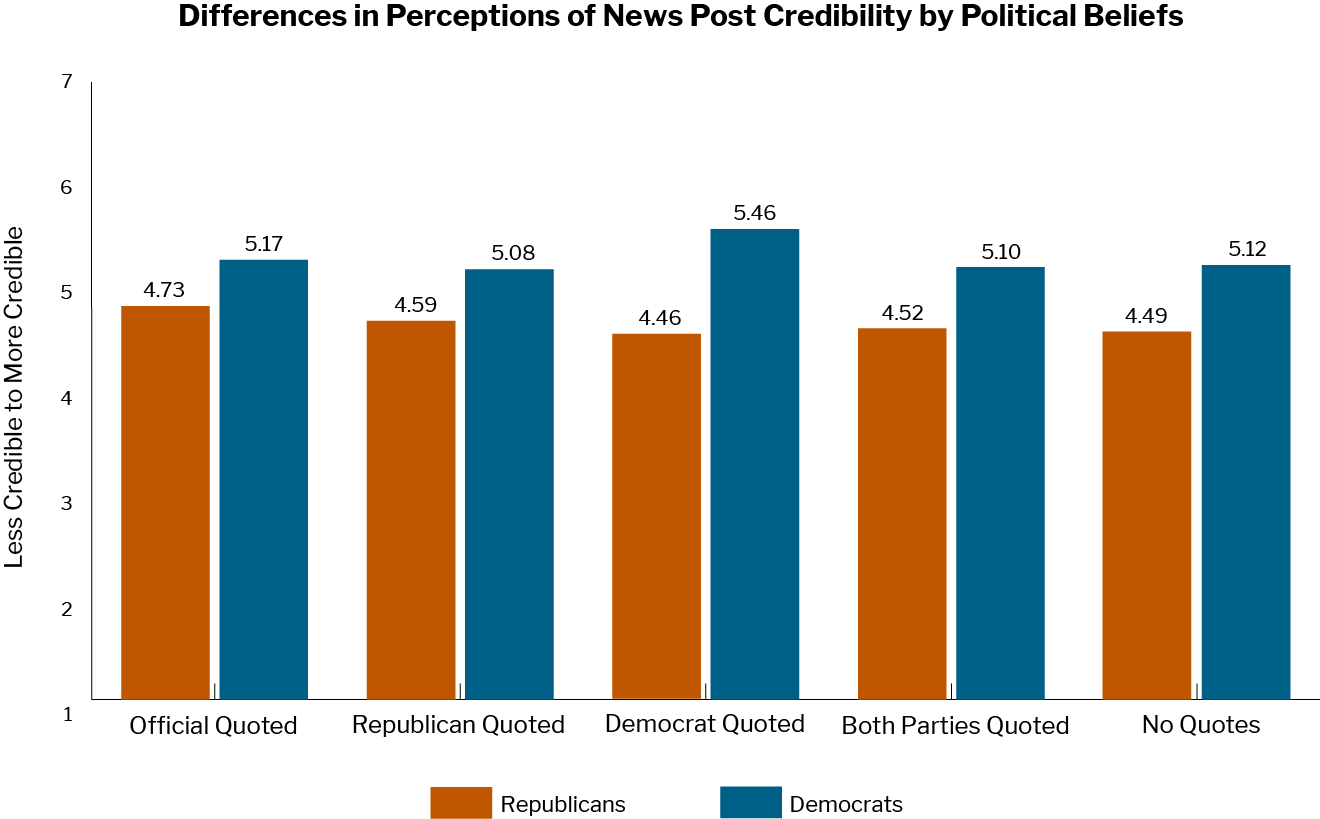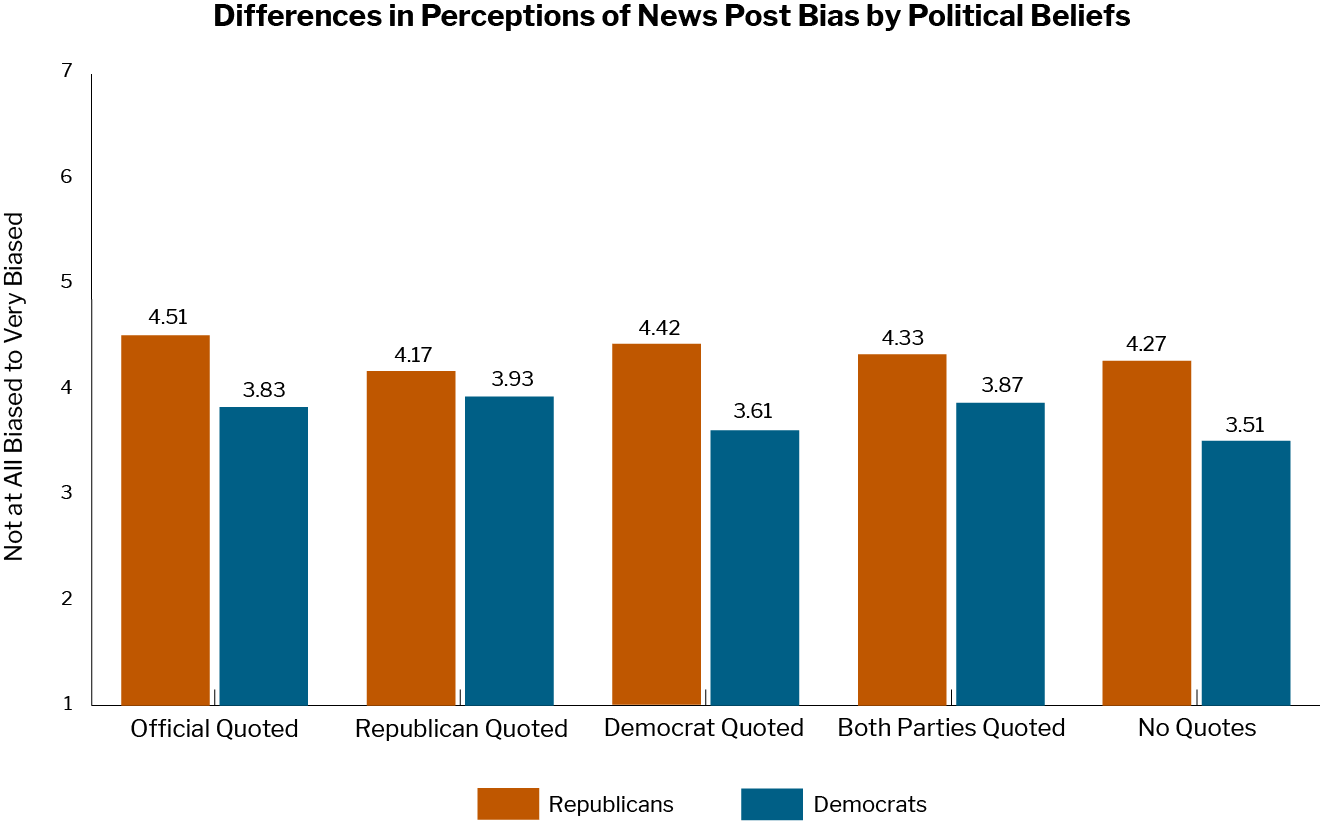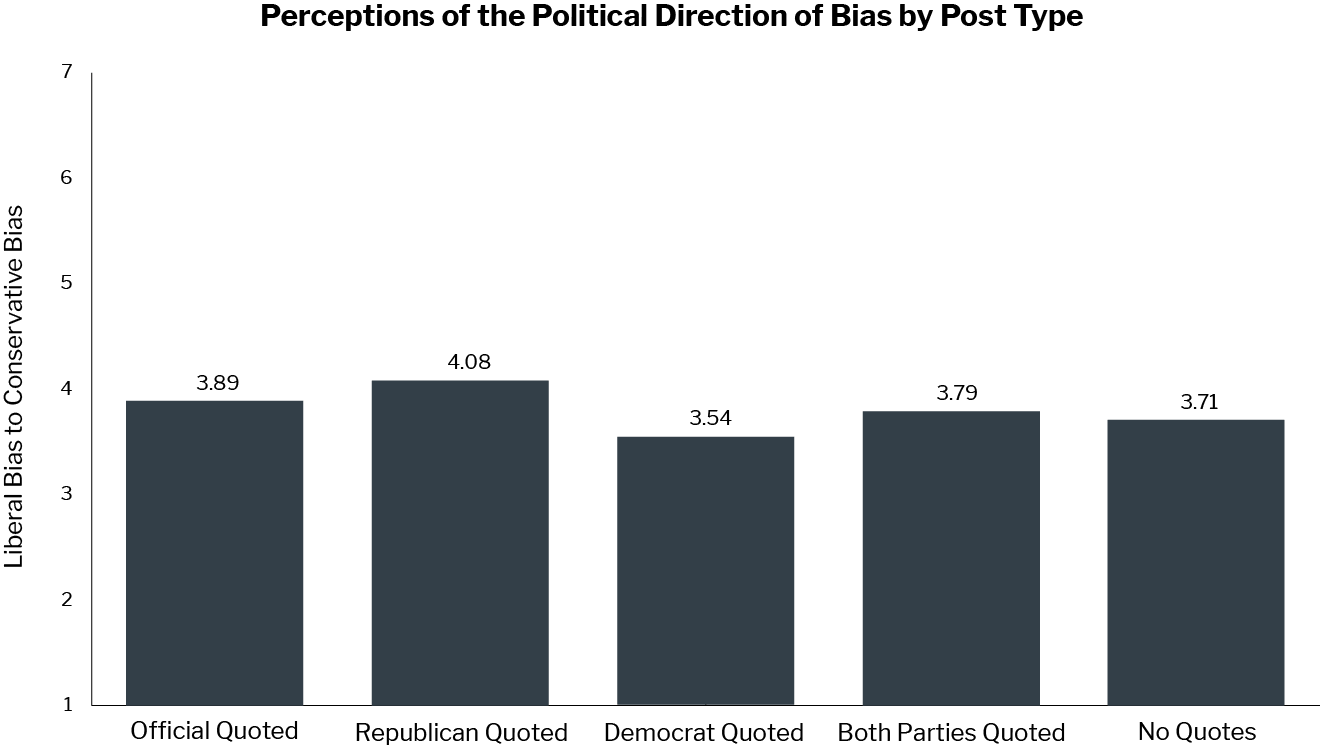
SUMMARY
Given the diminishing trust in U.S. news media, especially among political conservatives, the Center for Media Engagement set out to examine whether certain storytelling approaches affect people’s perceptions of credibility and bias.
The findings emphasize that Republicans and Democrats perceive news stories very differently and perceive bias when the other political party is quoted. Members of both parties had the highest credibility ratings for news posts that only quoted a government official. When it came to bias, Democrats and Republicans differed in how they discussed the topic and which storytelling approaches they perceived as biased.
THE PROBLEM
Waning trust in the mainstream news media is a persistent problem in the United States,1 particularly among political conservatives.2 This is concerning for newsrooms and for society because it may amplify divisions and encourage the spread of misinformation.
Our research3 has found that both the general public and political conservatives may perceive common journalistic practices, like adding context to a story, as fostering bias, which undermines trust. These findings led us to examine whether certain storytelling approaches affect people’s perceptions of credibility and bias.
Using mock Facebook news posts, we tested five storytelling approaches: posts that quote only a government official, posts that quote only a Republican lawmaker, posts that quote only a Democratic lawmaker, posts that quote both Democratic and Republican lawmakers, and posts that provide context about why the story is important but no quotes.
This research is part of our connective democracy initiative, funded by the John S. and James L. Knight Foundation. Connective democracy seeks to find practical solutions to the problem of divisiveness.
KEY FINDINGS
- Democrats rated all news posts as significantly more credible than Republicans did, regardless of the storytelling approach. Members of both parties had the highest credibility ratings for news posts that only quoted a government official.
- Republicans rated three out of the five storytelling approaches as significantly more biased than Democrats did (quoting only a government official, quoting only a Democratic lawmaker, and providing context but no quotes).
- Democrats and Republicans perceived the posts that quoted only a Republican lawmaker and the posts that quoted both Democratic and Republican lawmakers as similarly biased.
- Participants perceived the posts that quoted only a Republican lawmaker as biased toward the right and posts that quoted only a Democratic lawmaker as biased toward the left. They did not perceive the other posts as biased in a particular direction.
- Democrats and Republicans differed in how they discussed the topic of news bias, with Democrats focusing more on skepticism and a specific news outlet (FOX News) while Republicans pointed to message framing and what they perceived as emotionally charged language.
IMPLICATIONS FOR NEWSROOMS
- Our findings emphasize that Republicans and Democrats perceive news stories very differently and perceive bias when the other political party is quoted.
- Journalists should consider varying storytelling approaches with a particular eye toward increasing perceptions that news posts and stories are credible and lack bias.
- Journalists should be cautious to balance quotes between Republican and Democratic lawmakers.
FULL FINDINGS
Participants were shown a Facebook post about one of two news topics (Defense Secretary Pete Hegseth sharing attack details on the Signal messaging app or President Donald J. Trump’s widespread trade tariffs). The post they viewed utilized one of five storytelling approaches developed from earlier studies:4 quoting only an official; quoting only a Republican lawmaker; quoting only a Democratic lawmaker; quoting Republican and Democratic lawmakers; or providing context to explain the story’s importance but not including quotes.

Notes: Above are examples of news posts about President Donald J. Trump’s widespread trade tariffs.
News Post Credibility
Democrats rated all news posts as significantly more credible than Republicans did, regardless of the storytelling approach.5 When members of both parties are considered together, they gave the highest credibility ratings for a news post that only quoted a government official.

Notes: Participants rated how “accurate,” “authentic,” “believable,” and “trustworthy” the news post they viewed is on a scale of 1 (describes very poorly) to 7 (describes extremely well). Responses were averaged into a single measure of credibility. For all storytelling approaches, Democrats rated news post credibility as significantly higher than Republicans did at p < .05.
Perception of News Post Bias
Republicans rated three of the five posts as significantly more biased than Democrats did (quoting a government official, quoting only a Democratic lawmaker, providing context but no quotes).6 Republicans and Democrats rated two posts — one that quotes only a Republican and one that quotes both a Republican and a Democrat — as similarly biased.

Notes: Participants rated the level of bias of the news post they viewed on a scale of 1 (not at all biased) to 7 (very biased). Republicans rated significantly higher bias than Democrats did for three of the five storytelling approaches at p < .05. Their ratings were statistically indistinguishable for the posts that quoted only a Republican or that quoted both a Republican and a Democrat.
Political Direction of News Post Bias
Findings demonstrate that the type of news post produced significant differences in perceptions of the political direction of the news post bias.7 Specifically, participants perceived a post that quoted only a Republican lawmaker as significantly more biased toward the right and a post that quoted only a Democratic lawmaker as significantly more biased toward the left. All other ratings were not significantly different.

Notes: Participants rated the direction of bias of the news post they viewed on a scale of 1 (biased toward liberals) to 7 (biased toward conservatives). Participants rated the post that quoted only a Republican as significantly more biased toward conservatives than the post that quoted only a Democrat at p = .002. All other ratings were not significantly different.
Discussion of News Bias
We asked participants one open-ended question: “Please explain what makes you perceive a news post as biased. You can take as much space as you’d like.” Our analysis of their answers found that Democrats tended to use phrases like “untrustworthy” and “FOX News” in their explanations, while Republicans were more likely to use terms like “framing” and “emotionally charged language.”8
Here are examples of what Democrats wrote in response to the question:
- “The media can easily be manipulated.”
- “Since Trump has been [in] the White House journalism has suffered a critical blow of being known for its trust worthiness. Many journalists have resigned because of Trump. Trump want[s] to personally punish anyone who speaks out against him. The news has become very fake and one-sided. Americas democracy and freedom of the press and free speech are at risk.”
Here are examples of what Republicans wrote:
- “Because it says negative things about Republicans.”
- “Generally if it leads the reader to a conclusion that I know not to be truthful. I consider a post biased if it includes figures that are known to be incorrect to make the reader support a particular party, or uses quotes that are taken out of context.”
METHODOLOGY
Participants were recruited through Prolific, an online research platform that helps researchers recruit and manage participants. Prolific currently has more than 200,000 global active users, with 16,000 survey panelists in the U.S., who opt in to take surveys and are paid for their participation through Prolific. Participants had to be U.S. residents who are at least 18 years old. We set up a quota for political beliefs to ensure we would recruit roughly half participants who are Democrats and half who are Republicans. This was neither a random nor a representative sample. Participants were paid $1.50 each for completing the study, which took 9.92 minutes on average to finish.
After consenting,9 participants (N = 921)10 were randomly assigned to view one of 12 mock Facebook posts designed to appear as if it came from a news organization. Participants were randomly assigned to either view a single post about Hegseth’s Signal chat controversy or a single post about Trump’s tariffs. We chose these topics because they were focal points of debate at the time of the study. The posts appeared to be from The Gazette Star, a mock news site we created.
Additionally, participants were randomly assigned to one of five news post storytelling approaches that were designed based on interview data from our research11 about how political conservatives perceive news bias and other factors that influence bias and credibility perceptions. These approaches were: a post that quotes only an official, a post that quotes only a Republican lawmaker, a post that provides context but no quotes, a post that quotes only a Democratic lawmaker, and a post that quotes both Democratic and Republican lawmakers. This resulted in 12 conditions.

Suggested Citation:
Masullo, G.M., & Yao, S. (August 2025). Quotes and credibility: How storytelling approaches shape perceptions across party lines. Center for Media Engagement. https://mediaengagement.org/research/quotes-and-credibility
- Newman, N., Fletcher, R., Robertson, C.T., Ross Arguedas, A., and Nielsen, R.K. (2024). Reuters Institute Digital News Report, 2024, Reuters Institute. https://reutersinstitute.politics.ox.ac.uk/digital-news-report/2024.[↩]
- Shearer, E., & Eddy, K. (2024). Republicans have become more likely since 2024 to trust information from news outlets, social media. Pew Research Center. https://www.pewresearch.org/short-reads/2025/05/08/republicans-have-become-more-likely-since-2024-to-trust-information-from-news-outlets-social-media/; Gottfried, J., & Liedke, J. (2021). Partisan divides in media trust widen, driven by a decline among Republicans. Pew Research Center. https://www.pewresearch.org/wp-content/uploads/2021/08/FT_21.08.30_news_trust.png[↩]
- Wilner, T., Montiel Valle, D.A., Masullo, G.M. (2021). “To me, there’s always a bias”: Understanding the public’s folk theories about journalism. Journalism Studies, 22(14), 1930-1946. https://doi.org/10.1080/1461670X.2021.1979422[↩]
- Wilner et al., 2021; Masullo, G.M., Kim, S., & Duchovnay, M. (2025). “Bogeyman terms”: Understanding political conservative Americans’ folk theories about news bias. Journalism. Advance online publication https://doi.org/10.1177/14648849251348330; Masullo, G.M., Curry, A., Whipple, K.N., & Murray, C. (2022). The story behind the story: Examining transparency about the journalistic process and news outlet credibility. Journalism Practice, 16(7), 1287-1305. https://doi.org/10.1080/17512786.2020.1870529[↩]
- This was tested using a multivariate analysis of covariance (MANCOVA) with the five storytelling approaches and the two topics as independent variables, and credibility perception, perception of news bias, and direction of news bias as the dependent variables. The model included two covariates, pre-existing perceptions of news media bias on a scale of 1 (not at all biased) to 7 (very biased) [M = 4.93, SD = 1.33] and prior familiarity with the news post topic on a scale of 1 (not at all familiar) to 7 (very familiar) [M = 4.56, SD = 2.05], and an interaction between political beliefs and the storytelling approach. Credibility perception was measured using a scale adapted from Appelman, A., & Sundar, S.S. (2016). Measuring message credibility: Construction and validation of an exclusive scale. Journalism & Mass Communication Quarterly, 93(1), 59-79. https://doi.org/10.1177/1077699015606057. Participants rated how “accurate,” “authentic,” “believable,” and “trustworthy” the news post was on a 1 (describes it very poorly) to 7 (describes it extremely well) scale, and the responses were averaged together with high reliability, M = 4.99, SD = 1.32, α = 0.94. Neither the main effect, F (4, 893) = 0.68, p = .61, η2 = 0.003, nor the interaction effect, F (4, 893) = 1.44, p = .21, η2 = 0.006, were significant. Post hoc tests using Sidak showed that means for Democrats and Republicans differed significantly for each of the five storytelling approaches at p < .05.[↩]
- Perception of news post bias was measured by a single question where participants rated from 1 (not at all biased) to 7 (very biased) the level of bias they perceived in the post they viewed [M = 3.98, SD = 1.62]. This was tested using the same MANCOVA explained in endnote 5. No main effect was found for perception of bias, F (4, 893) = 0.82, p = .52, η2 = 0.004. Post hoc tests using Sidak showed that means for Democrats and Republicans differed significantly for three of the five storytelling approaches at p < .05. Means were statistically indistinguishable for the post that quoted a Republican and the post that quoted both a Republican and a Democrat.[↩]
- Direction of bias was measured by a single question where participants rated from 1 (biased toward liberals) to 7 (biased toward conservatives) the direction of bias they perceived in the post they viewed [ M = 3.80, SD = 1.41]. This was tested using the same MANCOVA explained in endnote 5. Results produced a significant main effect for the post type, F (4, 893) = 3.89, p = .004, η2 = 0.02, but not a significant interaction effect between political beliefs and storytelling approach, F (4, 893) = 0.11, p = .98, η2 = 0.00. Post hoc tests using Sidak showed that participants rated a post that only quoted only a Republican lawmaker as significantly biased toward the right, and a post that quoted only a Democratic lawmaker as significantly biased toward the left.[↩]
- We conducted separate Latent Dirichlet Allocation (LDA) topic modeling analyses for two partisan groups (Democrats, Republicans) based on their responses to the open-ended question. We also applied the Fighting Words algorithm using the ConvoKit Python library. The analysis compared open-ended responses to the survey question across self-identified partisanship. Responses were structured into a ConvoKit Corpus object, where each utterance was tagged with metadata including the speaker’s party affiliation. Two selector functions were defined to identify Democrat and Republican utterances, respectively. We then used the FightingWords transformer to compute z-scores for each n-gram (unigrams, bigrams, and trigrams), quantifying the extent to which each phrase was disproportionately used by one group relative to the other. Finally, we sorted the resulting z-score table to identify the most distinctively partisan language and visualized the top n-grams associated with each group.[↩]
- The Institutional Review Board at The University of Texas at Austin approved the project on May 28, 2025.[↩]
- Initially, 1,036 started the experiment but data were not analyzed for those who may have taken the survey more than once as evidenced by a duplicate IP address (n = 42), were not 18 years or older (n = 14), failed at least one of the three attention checks (n = 4), finished the survey too quickly (n = 27), finished the survey too slowly (n = 19), could not see the news post (n = 1), and did not read the news post (n = 8). This resulted in N = 921.[↩]
- Wilner et al., 2021; Masullo et al., 2025; Masullo et al., 2022.[↩]



